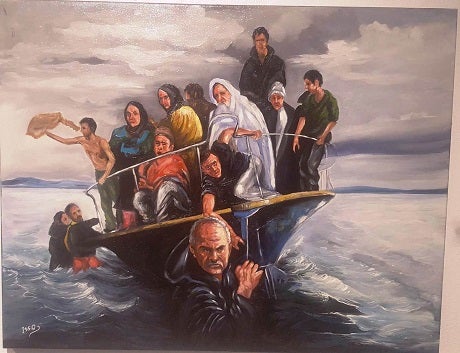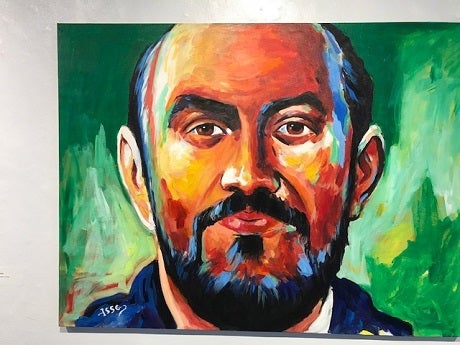ERBIL, Kurdistan Region – A Kurdish artist, forced to flee his home in Syria, hopes to educate people in his new home of Canada about the long struggle of the Kurdish people through his artwork.
Janso Isso’s story begins in Hasakah, northeastern Syria where he was born in 1974. It was there that he realized his talent for art at the young age of seven, saying his talent is a gift from God.
“If a person is gifted by God, God will help him to accomplish his goals,” Isso stated in a video interview with Rudaw.
Kurds in Syria were oppressed, subjected to discrimination, kidnappings, abuse, torture, and killing. Many did not have national identity or travel documents.
Isso stated that no one could even think creating art during those times, as the most important thing for a person to do was to work and support their family.
In 1998, Isso left Syria in search of work in Lebanon and to follow his dream of becoming an artist. With no official training, he worked hard and taught himself how to paint and sculpt.
Isso returned to Syria in 2003 to get married, but was only able to stay for one year.
In 2004, at least 30 Kurds were killed in a government crackdown after riots in the northern Syrian city of Qamishli. Isso took his wife and returned to the safety of Lebanon.
They remained in Lebanon, except for a few months in 2006 when they returned to Syria to escape unrest in Lebanon between Hezbollah and Israel.
A better life
From 2006 until the Syrian civil war started in 2011, Isso states that he and his family lived a very comfortable life in Lebanon thanks to his artwork. However, the cost of living in Lebanon was very expensive, he said.
“I worked extra-long hours to make sure my family, including my father and brother, were taken care of,” he said. “But at least we had stability.”
Isso was able to find work painting portraits and intricate murals in homes and palaces, as well as sculpting for home and government decor.
One of his highest honors at the time was to decorate the palace in Lebanon of a Qatari emir with his paintings and sculptures.
Isso was also able to meet many prominent people such as politicians and musicians through his work. He and his family were living a comfortable life.
Hard times
The Syrian civil war, which began in 2011, caused massive instability in the region. Within a short period of time between 1.5 and 2 million people from Syria were flooding the cities of the small country of Lebanon and a humanitarian crisis erupted.
Isso said that this became a very difficult time for everyone living in Lebanon; Kurds, Syrians and Lebanese alike found it hard to find a job, pay rent, and in some cases even obtain food.
Many refugees were desperate to save their families and were using Lebanon as a gateway to make it to Turkey or Greece by boats to continue on to Europe to seek asylum.
Isso considered taking the same route, but at the last moment, he changed his mind as he didn’t want to put his wife and two daughters in danger.

Janso Isso's painting of refugees making the dangerous boat trip to Europe. Photo: Sergey Ponomarev
It was during those hard times that Isso’s paintings and sculptures started to “show the pain of my people traveling to Turkey and Greece.”
The last time Isso returned to his hometown of Hasaka was in 2011, after the president had signed a decree which provided citizenship for Kurds. It was at that time that Isso was able to obtain his Syrian passport.
He noted that due to war and conflict, he had rebuilt his home twice, but now he doesn’t know if his house is still standing or not.
A touch of luck and kindness from afar
Through some friends and a cousin in Canada, Isso came to know of a program that could help his family relocate to Canada, which was accepting refugees.
After a two-and-a-half-year wait, he finally received the sponsorship to move to Canada through a group in Nova Scotia called the Crichton Park Friends of Refugees. The group consisted of ten Canadian families who raised enough money to support Isso, his wife Himo Hussin, and their daughters, Mavie and Melly, for one year.
Isso and his family arrived in Dartmouth, Nova Scotia a little over eight months ago.
Isso is currently studying English and his wife and children are studying English and French. Once he is fully settled into his new life, he hopes to continue his artwork.
Inspiration
Isso told Rudaw that most of his inspiration comes from famous Kurdish political figures, poets, artists, musicians, writers, and filmmakers. He’s painted many of these popular Kurdish icons with the hopes to show their faces, which are painted in bright and intense colors, so that people will ask who they are. In this way, he can explain how each of them has contributed something special to the Kurdish people.
When Isso was living in Syria and Lebanon, he didn’t have the freedom or artistic outlets to express his art in the way he wanted to, he said, especially in regards to politics.
Now that he is in Canada, he no longer has to be afraid of what he may paint. He is free to paint as he wishes and display his work.
With his newfound artistic freedom, he plans on painting Kurdistan’s flag in the near future. A flag that he hopes to see recognized on the world stage after the Kurdistan Region’s independence referendum.
“I hope and I’m very optimistic that the outlet of the referendum will make Kurdistan an independent state and that the flag of Kurdistan will fly at the United Nations,” Isso said.
Janso Isso - Path to the Light
In his first ever art exhibition, titled Path to the Light, Isso will be displaying his artwork, with the help of his sponsor Deborah Woolway, at the Anna Leonowens Art Gallery in Halifax, Nova Scotia between July 11 and July 22. He hopes to be able to sell the artwork that’s displayed from between $150 to $500 per piece.
Isso told Rudaw it would “be a dream” to eventually have an art exhibition in the Kurdistan Region.

Janso Isso's painting of Qazi Muhammed, the leader of the short-lived Kurdish republic of Mahabad.




Comments
Rudaw moderates all comments submitted on our website. We welcome comments which are relevant to the article and encourage further discussion about the issues that matter to you. We also welcome constructive criticism about Rudaw.
To be approved for publication, however, your comments must meet our community guidelines.
We will not tolerate the following: profanity, threats, personal attacks, vulgarity, abuse (such as sexism, racism, homophobia or xenophobia), or commercial or personal promotion.
Comments that do not meet our guidelines will be rejected. Comments are not edited – they are either approved or rejected.
Post a comment